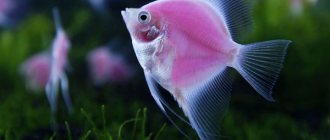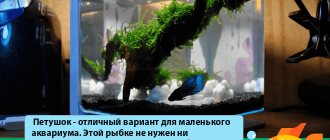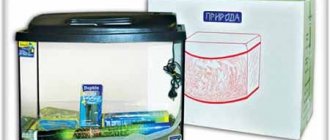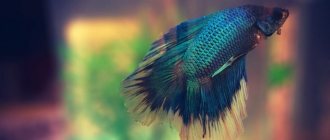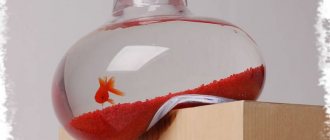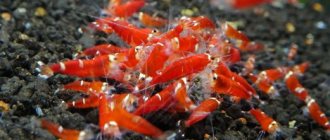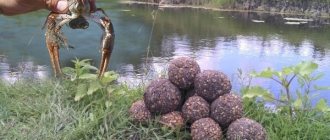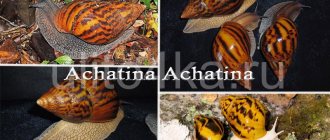4.6
(68)
Every novice aquarist, when buying his first aquarium, thinks about who will live in it. This question is complex, since on the modern market there are incredibly many different beautiful fish that differ in price, appearance, conditions of detention and other characteristics.
It is not easy to finally decide, unless a lover of underwater flora and fauna wants something specific. If he doesn’t have any particular idea about who he will put in his aquarium, then it is better to purchase unpretentious types of fish.
Besides zebrafish
Perhaps we all know the amazing endurance and adaptability of zebrafish. It is not surprising that the tenacious little fish is one of those species that is recommended to beginners or placed in a new empty aquarium when, for unknown reasons, they want to establish a biological cycle after stocking. Danios are hardy, quickly adapt to new conditions and, although they cannot boast of bright colors, are cute and active.
But many do not understand that other more attractive species related to zebrafish have similar qualities. The orange-finned zebrafish ( Brachydanio kyathit) can rightfully be proud of the perfection of its stripes. The fish has black stripes on its body, which perfectly set off its fiery red fins. The orange color also appears in the color of the entire body during the mating season. There are both classic and spotted colors of Brachydanio kyathit.
The photo shows an Orange-finned zebrafish (Brachydanio kyathit)
Species name: Brachydanio kyathit. Size: 4 cm Origin: Myanmar. Chemical composition of water: pH from 6.5 to 7.5. Soft to moderately soft water. Temperature: 16 – 26°C. Minimum aquarium size: 80 liters with a base of 90x30 cm.
Pearl danio (Brachydanio albolineata)
Most of us see the Pearl Danio (Brachydanio albolineata) regularly, but have no idea that it can live in moderate temperatures. These glossy little fish look exquisite, shimmering with colors like an oil slick on the surface of the water, and their sides reflect light, changing colors from metallic blue to green, purple, pink and gold. In poor conditions they look like a pale version of Hemigrammus erythrozonus, but with good food, water and light they begin to shine.
Pearl danio (Brachydanio albolineata)
Species name: Brachydanio albolineata. Size: 5 cm. Origin: Widely distributed in Southeast Asia. Chemical composition of water: pH from 6 to 8. Water from soft to hard. Temperature: 16–25°C. Minimum aquarium size: 80 liters with a base of 90x30 cm.
Danio fireflies (Celestichthys choprae)
Perhaps even more adorable are the little Danio fireflies (Celestichthys choprae). Like Pearl Danios, these fish glow and shine in the right light, and their fins are gold-plated at the edges. Their color changes depending on the light, but the fish's generally warm (pink or orange) body tones contrast nicely with the vertical blue-black stripes.
Danio fireflies (Celestichthys choprae)
Species name: Celestichthys choprae Size: 3 cm. Origin: Northern Myanmar. Chemical composition of water: pH from 6 to 7.5. Water ranges from soft to slightly hard. Temperature: 16 – 26°C. Minimum aquarium size: 65 liters with a base of 75x30 cm.
Danio "Golden Rings" or Danio tinwini (Brachydanio tinwini)
, perhaps the most brightly colored of all zebrafish. The body and fins are covered with black spots with a golden shining edging, they live together in a small aquarium, and the size of an adult is about 2.5 cm.
Danio tinwini (Brachydanio tinwini)
Species name: Brachydanio tinwini. Size: 2.5 cm. Origin: Northern Myanmar. Chemical composition of water: pH from 6.5 to 7.5. Water is soft to moderately soft. Temperature: 18 – 26°C. Minimum aquarium size: 40 liters with a base of 45x30 cm.
Bengal Danio (Devario devario)
Those with a large aquarium who want to watch the real action will be tempted by one of the wonderful species of Barilius - the Indian trout (Barilius bola), sometimes found for sale. As adults, these fish reach large sizes, they are pugnacious, and they have a surprisingly capacious mouth. It is better for specialists to keep them in large aquariums with a powerful current. Instead, consider a "budget" species of "barilium" - the Bengal zebrafish (Devario devario). They have the indefatigable energy and natural activity of smaller “danios”. Given enough space, a whirling school of these tall-bodied fish with greenish-blue sides flecked with warm gold creates a stunning sight. They reach about 7.5 cm.
Bengal Danio (Devario devario)
Species name: Devario devario. Size: 7.5 cm. Origin: Northern India, Nepal and Bangladesh. Chemical composition of water: pH from 6 to 8. Water from soft to moderately hard. Temperature: 15 – 26°C. Minimum aquarium size: 160 liters with a base 120 x 45 cm.
The best fish for a freshwater aquarium
5 Labidochromis yellow
Fish, whose body length reaches a maximum of 10 cm, are excellent for calm coexistence with many other underwater inhabitants. They belong to the cichlid family, and are the best in character. Only breeds with a similar appearance can cause irritation to them. The yellow color, rare for freshwater animals, will become richer if components rich in carotene are added to the food. In total, about 10 shades of this species are known. Aquarists choose Labidochromis for its bright color, unpretentious diet, and love for a minimalist interior. They only need strong filtration and fresh water at a temperature of 24-28 degrees. It is better to use fine sand or coral chips of almost any shade as soil.
4 Handsome Chromis
Wild populations of the ornamental aquarium inhabitant are found in the Congo River basin. The handsome Chromis inherited from his ancestors a stubborn character, a love of slow water, and a large number of plants. Despite the average size of 10-12 cm, one fish requires a container of water with a volume of at least 40 liters. There she feels spacious, examining not only the succulent parts of the plants, but also the root system. For complete comfort, this variety requires filtration and a weekly change of 30% of the water. Chromis is omnivorous and moderately active. Individuals of opposite sexes can show aggression mainly during the mating season when their characters are different. However, they are very caring parents to the detriment of the peace of mind of the other inhabitants of the aquarium.
3 Koi carp
The decorative version of the carp family is distinguished by a variety of colors. In addition to the usual red, black and yellow, through selection, koi have been obtained in exotic shades, which affects the cost of individuals. The fish have a body shape flattened on top, their size ranges from 12-17 cm. It is important that not only a glass aquarium, but also a backyard pond can be chosen as a habitat. Freshwater easily tolerate temperature changes in the range of 10-23 degrees, varying water hardness, and irregular filtration. Food can include dry food, live food, combined food, and even frozen food. The fauna of this species is characterized by a long life cycle.
2 Catfish ancistrus
These naturally unusual fish with a protective coloring are very active, inquisitive and sociable. They prefer their peers in terms of sociability, avoiding breeds that are too slow or have no scales. You will give them pleasure if you decide to have dense thickets in which they could be in rare moments of solitude. Catfish love oxygenated water, so powerful aeration is simply necessary. The disadvantages of the species are the tendency to frequently clarify relationships between males and overeating. This can be avoided if you keep a male with females and adhere to a carefully composed, predominantly plant-based menu.
1 Botsia clown
Botia attracts attention with its contrasting striped color, wide size range (from 2-3 cm to 20 cm), and high sociability. With a large number of positive qualities, this is a bottom-dwelling fish that prefers the lower layers of water, as if hiding from prying eyes. Here she easily finds food thanks to the lower placement of her mouth. For it, it is necessary to prepare caves, grottoes, and snags in which the aquarium inhabitant could rest. The rest of the time, she sticks to a flock, so it is advisable to purchase several individuals at once. For this species, a spacious aquarium (from 100 liters) with water at a temperature of 21-26 degrees, where constant filtration is provided, is well suited.
Tetras
When it comes to colorful pelagic aquarium inhabitants, tetras hold a special place. These fish, like neons, cardinals, erythrosonus and lemonfish, fill pet store aquariums with color. Unfortunately, they are all truly “tropical” and like to bask in temperatures around 25°C. If they are kept for a long time at lower temperatures, they will fade.
Diamondback tetra (Hyphessobrycon anisitsi)
However, there are a couple species of tetras that don't mind a cool shower, as they naturally inhabit regions of South America where the sun doesn't always shine. Diamondback Tetra is commonly seen . The temperature of the natural habitat of these fish varies greatly. If they are kept at the maximum temperature of the tolerance range, the lifespan will be significantly reduced, similar to fast-forwarding film. They are tall-bodied fish measuring 6 cm in size with orange/red fins that gracefully highlight their overall greenish-blue coloring, and a black spot adorns the caudal peduncle. There are also albinos in which only the color of their fins is preserved. The fish may turn out to be “restless”, so choose its tankmates carefully. Keeping them in groups of ten or more often helps distribute their antisocial behavior among all members of the pack, then aggression ceases to be a problem.
Diamondback tetra (Hyphessobrycon anisitsi)
Species name: Hyphessobrycon anisitsi. Size: 6 cm. Origin: Brazil, Paraguay, Argentina and Uruguay. Chemical composition of water: pH from 5.5 to 8.5. Water ranges from soft to hard. Temperature: 16 – 28°C. Minimum aquarium size: 80 liters with a base of 90x30 cm.
Aphyocharax anisitsi
It is not so often found in stores, but still you should not ignore it. These are smaller and more graceful fish than the diamond-shaped tetras, reaching 5 cm in length, but they have the same frame of red fins around a metallic blue body. Again, a little aggression is possible, so keep them in large groups. Do not confuse these fish with the similar but smaller, more delicate and truly tropical Glass Tetras, or Prionobrama filigera.
Aphyocharax anisitsi
Species name: Aphyocharax anisitsi. Size: 5 cm. Origin: Argentina, Brazil, Paraguay and Uruguay. Chemical composition of water: pH from 6 to 8. Water from moderately soft to hard. Temperature: 18 – 28°C. Minimum aquarium size: 65 liters with a base of 75x30 cm.
Video
GURAMIACE FAMILY (Classification)
Species of Guppy.Poecilia reticulata
THE RAREEST FISHES OF THE WORLD OCEAN
Three-hybrid Parrot - All about aquarium fish | Fish of the species - Trihybrid Parrot
Barbs
Cyprinidae (carp and minnows) are the largest family of fish, so it's no surprise that they include many ideal temperate water species other than goldfish.
Scarlet or Odessa barb (Pethia padamya)
The magnificent Scarlet or Odessa barb (Pethia padamya) is so brightly colored that, given how it began to spread among hobbyists, namely through the then Soviet Ukraine, there were claims that it was an artificially bred or colored hybrid. Luckily, things have cleared up with the discovery of wild populations, so we can now appreciate it for what it is - one of the best temperate water species available.
Photo of the Scarlet or Odessa barb (Pethia padamya)
Species name: Pethia padamya. Size: 4.5 cm. Origin: Myanmar. Chemical composition of water: pH from 6.5 to 8. Water from moderately soft to hard. Temperature: 16–25°C. Minimum aquarium size: 65 liters with a base of 75x30 cm.
Black barb (Pethia nigrofasciata)
If we talk about cheerful tiger stripes, there are a huge number of striped beauties among the barbs. While many of these fish are either too combative or too tropical for mid-temperature aquariums, the Black Barb (Pethia nigrofasciata) is a worthy exception. In stores they often look like a faded tiger barb, but once they get into your aquarium containing fish of both sexes, the males will take on a deep purple-black color, fading to bright red around the head, and, covered with silvery scales, they will look like the night sky. The females will remain simply striped, but their presence will inspire the males to courtship and display their best colors.
Photo of Black Barb (Pethia nigrofasciata)
Species name: Pethia nigrofasciata. Size: 2.5 cm. Origin: Sri Lanka. Chemical composition of water: pH from 5.5 to 7.5. Water from soft to moderately hard. Temperature: 18–27°C. Minimum aquarium size: 65 liters with a base of 75x30 cm.
Fire barb (Pethia conchonius)
If you are a goldfish lover but don't have a large aquarium or pond space, then the Fire Barb (Pethia conchonius) is an obvious choice; All the charm and color of a goldfish, with the size of adults rarely exceeding 8 cm. Selective breeding over the decades has created a range of color forms and a comet-shaped fin, which has greatly removed the fire barb from its wild relatives, but has not made it any less popular.
Photo of Fire Barb (Pethia conchonius)
Species name: Pethia conchonius. Size: 6.5–9 cm. Origin: Pakistan, India, Bangladesh and Nepal. Water chemistry: pH 6 to 8. Slightly hard to hard water preferred. Temperature: 16 – 24°C. Minimum aquarium size: 80 liters with a base of 90x30 cm.
Red-lined torpedo barb, or Sahyadria denisonii
, has literally fascinated aquarium enthusiasts over the last decade. Their striking shark-like silhouette, attractive bright colors and peaceful nature have made them as popular as blue neons and angelfish. However, a fact that is not so well known is that these fish do not fare well in the constant summer conditions of tropical aquariums, where their metabolism is put on fast forward and their life span is shortened as a result. In an aquarium with moderate temperatures, they will keep up with seasonal changes and live a longer, more natural life. Like most barbs, they do better in large groups and look especially impressive, staying in the current created by the pump only with the help of occasional flicks of their branched tail, only occasionally changing their position to grab a passing tidbit.
Red-lined torpedo barb, or Sahyadria denisonii
Species name: Sahyadria denisonii. Size: About 10 cm. Origin: South India. Chemical composition of water: pH from 6.5 to 7.5. Water from moderately soft to hard. Temperature: 15–25°C. Minimum aquarium size: 160 liters with a base 120 x 45 cm.
Cause
Failure of heating equipment - a burnt-out heater in the case of cooling, a failed thermostat in both cases. Cooling can also occur as a result of a power outage, insufficient heater power (this can be critical on cold winter nights when the heating in the room is turned off), at exhibitions (where aquariums are often not heated at all); during transportation in cold weather. On the contrary, overheating may occur during transportation when the air temperature is high. Sometimes aquariums overheat during very hot weather or when exposed to direct sunlight. Aquarium lighting causes overheating of the water if the lighting fixtures are selected and positioned incorrectly. The reason may also be that the aquarium is too close to the heat source (for example, a heating radiator).
Subtropical bottom dwellers
Now that you've filled the top layers of your tank with colorful barbs, danios or tetras, you may want to add some bottom-dwelling species for balance. There are plenty of candidates from tropical sections that will enjoy cooler conditions.
Rainbow garra (Garra flavatra)
My personal favorite is the comical Garra flavatra . These colorful striped beauties are excellent seaweed eaters, but should never be purchased for that purpose alone. They look best in groups of five or more individuals, and their hierarchical battles are a spectacular sight.
In the photo, rainbow garra (Garra flavatra)
Species name: Garra flavatra. Size: 8 cm. Origin: Western Myanmar. Chemical composition of water: pH from 6.5 to 7.5. Water from soft to moderately hard. Temperature: 18–27°C. Minimum aquarium size: 80 liters with a base of 90x30 cm.
Marbled botia (Botia almorhae)
The stylish looking Marbled Loach (Botia almorhae) is another unexpected find for moderate temperatures. These attractively colored fish get their common name (Yo-Yo botia in English) due to the black and brown stripes on juveniles that resemble the letters Y and O. As they mature, this pattern develops into a more standard, but no less beautiful, net pattern. Like most bots, they enjoy company and should be kept in groups of at least five.
In the photo Marbled botia (Botia almorhae)
Species name: Botia almorhae. Size: 14 cm Origin: India, Nepal and Bangladesh. Chemical composition of water: pH from 6 to 7.5. Water ranges from soft to slightly hard. Temperature: 18–27°C. Minimum aquarium size: 160 liters with a base 120 x 45 cm.
Red spotted goby (Rhinogobius rubromaculatus)
If you're looking for a temperamental fish for your aquarium, look no further than the Red-spotted Goby (Rhinogobius rubromaculatus). This adorable baby micro-predator is always looking for something to eat. The males' mating plumage is magnificent: scarlet spots on a charming soft blue background and bright white edges of the fins. The females are paler, with pale yellow fin edges, but unless you have both sexes, you won't see the fantastic head-shaking and gaping jaws of the males as they court interested females. These gobies require good levels of dissolved oxygen and are accustomed to living in areas with strong water flow.
In the photo Red-spotted goby (Rhinogobius rubromaculatus)
Species name: Rhinogobius rubromaculatus. Size: 5 cm. Origin: Taiwan. Chemical composition of water: Water from moderately soft to slightly hard. Temperature: 15–25°C. Minimum aquarium size: 50 liters with a base 60x30 cm.
Are there fish that can tolerate extreme water?
Yes, several species can live temporarily in hot water. For example, some species of killfish that live in Death Valley can tolerate temperatures up to 45°C, and some tilapia swim in hot springs with temperatures around 70°C. But all of them cannot live long in such water; the protein in their blood simply begins to coagulate.
But there are more fish capable of living in icy water. At both poles there are fish that produce a kind of antifreeze in their blood, allowing them to live in water with temperatures below zero.
Cool catfish
Speckled catfish (Corydoras paleatus)
Few aquariums in my book can be considered complete without a catfish or two. Many of us know that the Speckled Catfish (Corydoras paleatus) does well in aquariums with moderate temperatures.
But what is less well known is that trilineatus , often sold under the name Corydoras trilineatus, is also well adapted to cool water.
Photo of Trilineatus (Corydoras trilineatus)
Species name: Corydoras trilineatus. Size: 2.5 cm. Origin: Amazon River basin in Peru, Brazil and Colombia. Chemical composition of water: pH from 6 to 7.5. Water ranges from soft to slightly hard.
Temperature: 16–25°C. Minimum aquarium size: 50 liters with a base 60x30 cm.
Bearded catfish (Scleromystax barbatus)
Add in their showy big cousin, the Bearded Catfish (Scleromystax barbatus), and this pair becomes an excellent alternative to the Speckled Catfish.
Photo of Bearded Catfish (Scleromystax barbatus)
Species name: Scleromystax barbatus. Size: 10 cm. Origin: Southeast Brazil. Chemical composition of water: pH from 5.5 to 7.5. Water ranges from soft to slightly hard. Temperature: 16 – 24°C. Minimum aquarium size: 50 liters with a base 60x30 cm.
Tarakatum (Megalechis thoracata)
If you have a large aquarium or want a tougher fish that can intimidate shellfish, consider the tough-looking, sausage-like catfish (Megalechis thoracata) , which can easily tolerate aggressive barbs and cool temperatures.
Photo of Tarakatum catfish (Megalechis thoracata)
Species name: Megalechis thoracata. Size: 15 cm. Origin: Brazil, Peru, Trinidad, Guyana, Martinique, Venezuela and Paraguay. Chemical composition of water: pH from 5.5 to 8. Water from soft to hard. Temperature: 17–28°C. Minimum aquarium size: 160 liters with a base 120 x 45 cm.
Symptoms
• Hypothermia: lethargy, lying on the bottom. When checking the water temperature, it is too low. If fish are exposed to refrigeration for too long, death may occur. • Overheating: rapid breathing, often shortness of breath, gills swollen and dilated. The fish hangs near the surface of the water, where the oxygen content is higher. Eventually exhaustion sets in, the fish lies on the bottom, followed by death from hypoxia. When checking the water temperature, it is too high.
Hypothermia or overheating occurs when the water temperature gradually drops or rises to values that are beyond the tolerance limits for a given species.
Application area
Cold-water aquariums for animals and seafood are widely used in shops and catering establishments. In such aquariums, such representatives of underwater fauna as:
For these species, it is possible to create optimal conditions in cold-water aquariums. In addition, a high-quality and impressively designed aquarium can become a magnificent decoration for a retail space. This is why cold-water aquariums are so widely used today.
Temperature conditions during fish transportation
Quite often, fish die on the way from the pet market or pet store to the aquarium. Fans transport almost all purchased fish in small containers (cans or bags).
In summer, many fish die from high water temperatures, and in winter, on the contrary, from low temperatures. Therefore, fish should be transported in thermoses, where the water temperature remains stable for a long time.
But if there are problems with thermoses due to the fact that they are simply not available, then the time for transporting fish from the pet market to their new habitat should be reduced to a minimum, so that the temperature of the water in the bag or jar changes by a maximum of two degrees compared to from the original one.
Maintaining temperature within optimal limits
To maintain a constant temperature regime, special systems and devices are used. They are designed for heating aquarium water. Devices can be purchased at pet stores.
Ways to change the temperature balance of water at different times of the year:
- to reduce the indicators, use aquarium refrigerators or ice;
- if an air conditioner is installed in a house or apartment, it will maintain the desired temperature;
- some fans blow the water surface with a fan;
- heating is carried out using special heaters; There are different types;
- In the absence of special devices, you can use a regular heating pad.
When using professional devices, the guarantee of correct temperature control increases.
When choosing a thermostat for heating liquid, you need to take into account the volume of the aquarium. Its power should be sufficient to fully heat water conditions. It is better to attach the device near the aeration filter on the back wall of the tank. There are models that are attached to an external filter.
It is important to evenly distribute the heat that comes from the heater throughout the aquarium. The thermostat must be completely submerged in water. It is necessary to ensure that the heated reservoir spreads throughout the entire tank, otherwise it will overheat and the system will quickly fail.
When setting the desired temperature in the first 6-12 hours, you need to monitor the indicators and the level of heating of the aquarium reservoir. It happens that the thermometer scale does not always correspond to the actual water temperature, or the system is not suitable for the volume of the aquarium.
Monitoring of indicators is carried out using thermometers.
If temperature fluctuations in the room exceed 4-5 degrees, you need to use heaters with automatic temperature control, which help maintain a constant set point.
How to take a temperature measurement
To measure, aquarists use special thermometers. They are placed in the middle layer of the aqueous medium, at the maximum distance from the heater.
It is better to purchase a special thermometer that is immersed in the pond rather than attached to the outside of the aquarium. A thermometer attached to the outside measures not so much the water as the air surrounding the aquarium.
Measuring instruments:
- water thermometer with suction cups;
- thermolator-heater.
- Today there are several types of devices:
- Electronic - accurate thermometer. Advantage - it starts beeping when the regime is violated. The disadvantage is the high cost.
- Mercury is an accurate and easy-to-use device. The advantage is the price, but if it breaks, all the inhabitants in the aquarium will die.
- Liquid crystal is an innovative device in the form of a thin strip with a color scale. The disadvantage is the low accuracy of the indicators.
- Alcohol is a convenient, but short-lived device. Inexpensive in price, but gradually loses measurement accuracy.
Technical solutions
Cold-water aquariums differ from the usual varieties of industrial and decorative aquariums in that, in most cases, they do not use heating systems. Moreover, to ensure the required temperature conditions, especially in the warm season, special aquarium refrigerators are used in cold-water aquariums. This is equipment that pumps water from the aquarium through a refrigeration unit, thereby maintaining its temperature in the required range.
Methodical manual from newspaper tubes for preschoolers “Diversity of fish in cold water bodies”
Freshwater or saltwater aquariums are not only impressive decorations for shopping centers and restaurants, but also a great commercial move. Such equipment is a mini-model of a natural reservoir, thanks to which it is possible to provide living products with the conditions necessary for life.
This solution will guarantee that you will offer customers only fresh fish and seafood, and visitors will clearly see this. Not a bad way to earn the buyer’s trust, isn’t it? Let’s look at the nuances of making such tanks using the example of a cold-water aquarium in the “DREAM FISH” restaurant.
